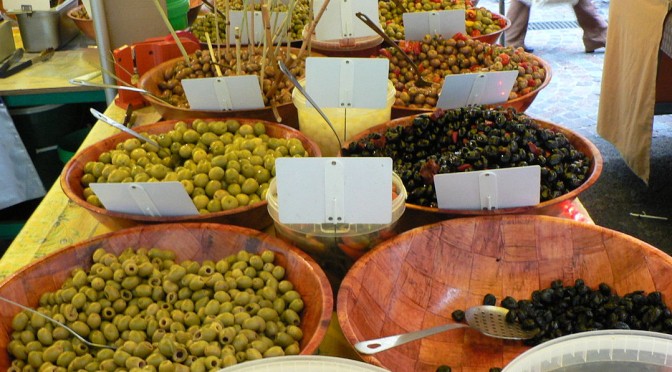I have a mixed relationship with olives. I never cared for the taste of them, so I wasn’t one of the kids who sat nibbling on jumbo olives perched on each of my fingertips. But I liked olives cooked into my food and the flavor that added, so most of the time, I use them in the recipe. Not that I’m adverse to serving jars or platters of the various types of olives at a gathering, but I’m just not likely to be eating them.
Olive oil on the other hand…
 No, not that Olive Oyl!… is very useful in cooking just about anything. I have a supply of that in my kitchen at all times. It’s the choice for pesto and salad dressing because it has a clean, fresh taste.
No, not that Olive Oyl!… is very useful in cooking just about anything. I have a supply of that in my kitchen at all times. It’s the choice for pesto and salad dressing because it has a clean, fresh taste.
One of the oldest tree species on the planet, the humble olive has been a part of humanity — and animal – diets for thousands of years. Carbon dating has placed olive trees in Spain as far back as 8,000 years ago. Fossilized leaves were found in the volcanic ash on Santorini that go back 37,000 years B.C. Humans have cultivated it for around 5500 years or longer. The trees themselves live a long time with many being hundreds of years old and at least one dating to 2,000 years old. They came from the Mediterranean and Western Asia regions, spreading across the globe from there. It’s likely that the Spanish brought the olive to the Americas where there is no evidence of their existence prior to the 1500’s.
The olive has figured in many cultures. Its leaves symbolized peace and prosperity. It was, after all, the twig that the dove brought back to Noah to show that land, and at least an olive tree, existed after the great flood, so it also had mention in the Bible.
These days, olives are still a big crop in the Mediterranean countries. Spain is the largest producer with about 6 millions tons a year, followed by Italy with 3.6 million tons. Greece, Syria and Turkey are also major producers. Only about 10% of the crop is keep for eating while the rest are crushed to make olive oil. The main producer of olives in the US is California where they are grown on about 27,000 acres in the Central Valley. If you’ve noticed some of my previous blogs, California is a major producer of much of the food I’ve highlighted. This means that the drought conditions the west is currently experiencing will likely impact the farmers and our food chain. Expect higher prices at the market.
Uses for Olives and Olive Oil
From a culinary and low carb standpoint, the olive and its oil has many uses and is an excellent as it is low carb and good for you. It makes a great snack, if you like the taste of olives, and can be purchased with different stuffings in the pit hole, such as garlic or pimento. Or you could put a little cheese in it. Here’s a few ways you can use olives:
You can make a tepenade or spread from olives by chopping them in a food processor with garlic, olive oil, parsley and a little salt to taste. Use as a dip or spread on crackers, or cheese or vegetables.
Add olives to your salad. Chop or slice them or use them whole.
Add them to the appetizer plates for a family dinner. Try two or three varieties for color.
Nutrition information for black jumbo olives – 1 olive
Calories:6.7 Fat: 0.6 g Net Carbs: 0.2 g Protein:0.1 g
Nutrition information for olive oil 1 tablespoon
Calories:119.3 Fat: 1.8 g Net Carbs: 0.0 g Protein: 0.0 g
Recipes
As I mentioned, I like to cook with chopped or sliced olives and I do have a few recipes on Skinny Girl that use olives:
Spaghetti Squash Tamale Pie
Tostado Con Carne
Bacon with Alfredo Sauce Pizza
So, folks, how do you like your olives?
All comments relevant to my posts are welcome. SPAM is not. If the post has nothing to do with my site content, it will not be posted.
Information for this article was pulled from World’s Healthiest Foods, Wikipedia, Encyclopedia of Life
The top photo is from Wiki Commons and is used with permission – “Olives au marche de Toulon p1040238” by David Monniaux – Own work. Licensed under CC BY-SA 3.0 via Wikimedia Commons –
The photo of Olive Oyl is from OliveOylloves.com, the official Olive Oyl site.



I’ve always wondered what the difference is between virgin olives oil and EXTRA-virgin olive oil.
–Mee (The Chinese Quest)
It’s the number of pressings of the olive. EVOO is the first, or purest pressing of the olives and is done cold, with just pressure. It’s supposed to be the purer and fruitier taste. It’s lowest in acidity at 1%. Virgin olive oil is also a first pressing, but with 3% acidity. Other than that, it’s the price of the bottle. I can’t tell the difference.